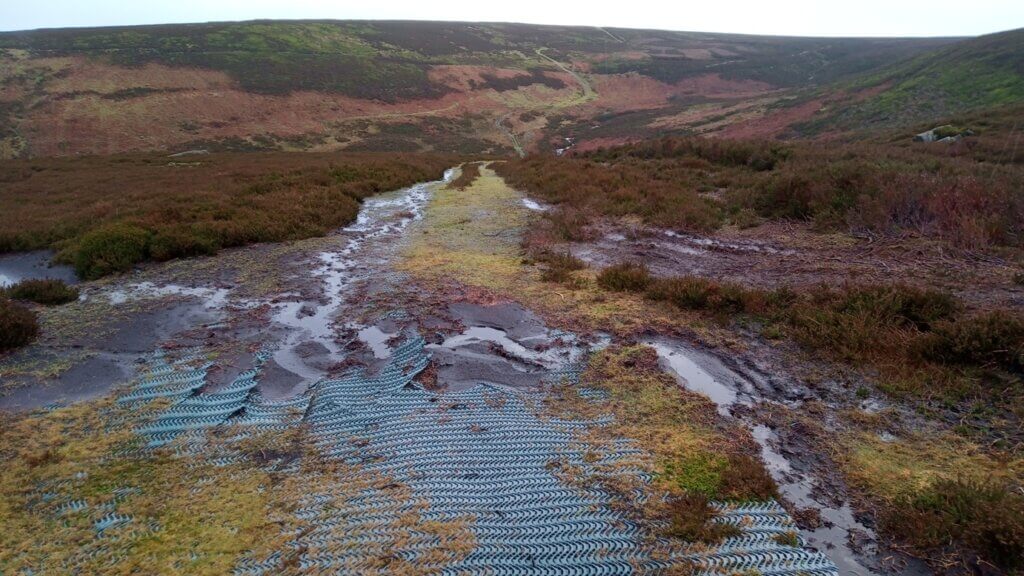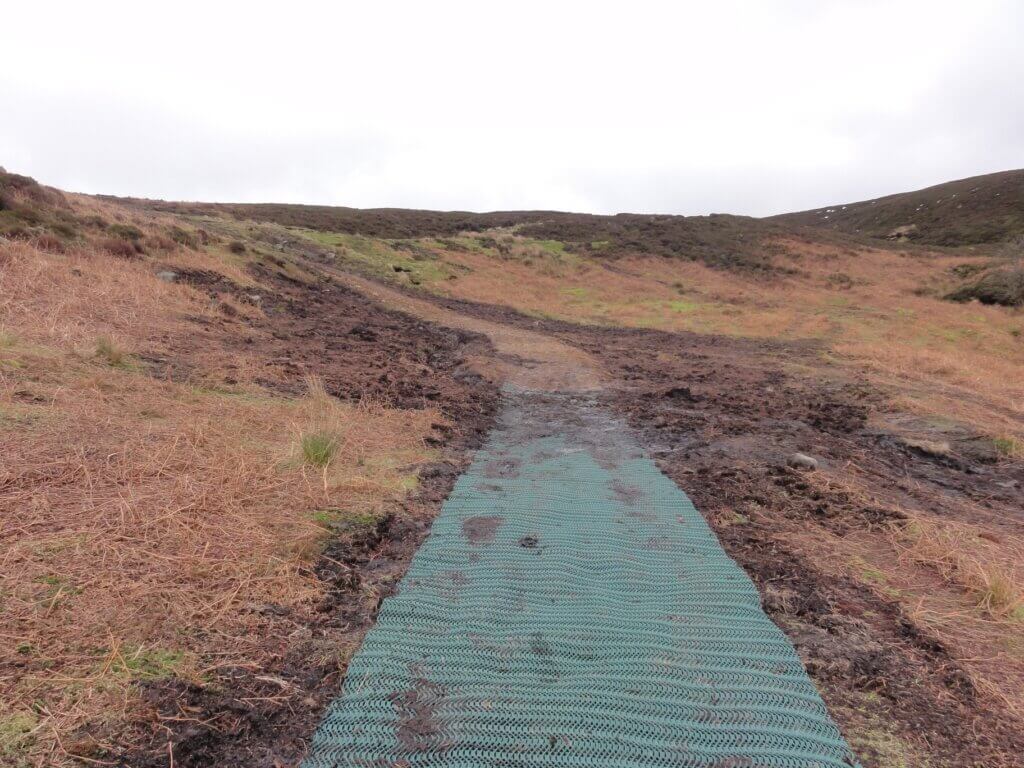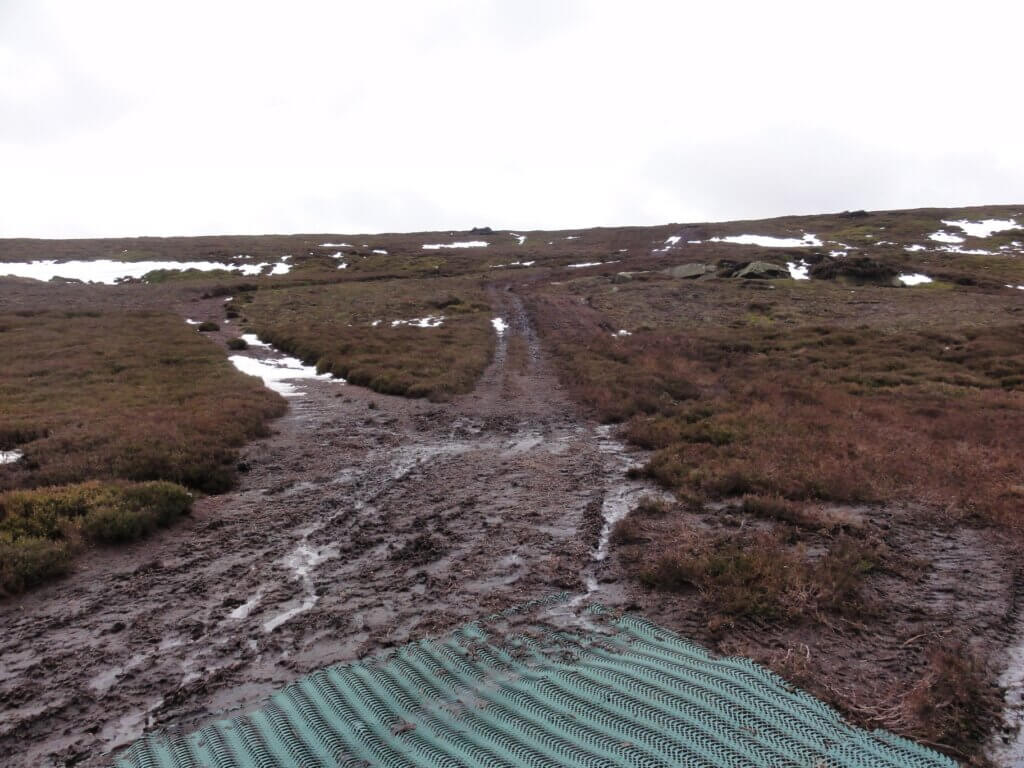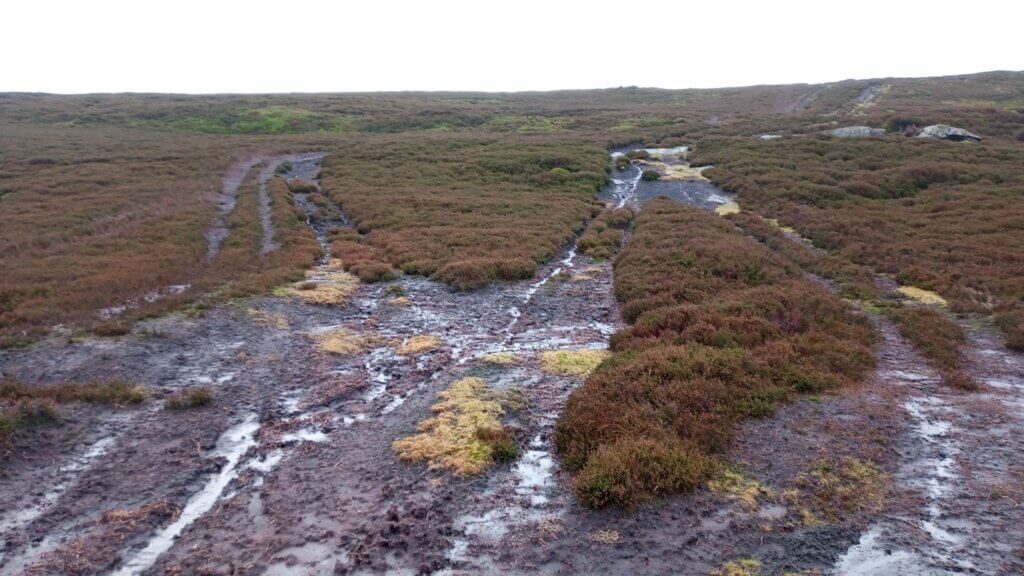
Bob Berzins is a campaigner and activist.
His previous guests blogs here all focus on the management, or mismanagement, of upland areas such as the Peak District, Walshaw Moor and the North York Moors. See also his novel Snared.
In 2014 and 2015 two surfaced tracks were constructed on the grouse moors of the north east Peak District, both with approval of Natural England. The purpose of Natural England is to help conserve, enhance and manage the natural environment for the benefit of present and future generations. But the impact of these tracks both visually and on the conservation features of these areas, only leads me to the conclusion that Natural England supports the short term priorities of grouse shooting rather than long-term preservation of these areas for future generations. I’ve written about these tracks before – click here for all Bob’s previous guest blogs (see especially 13 Feb 2017, 11 Jan 2019 and 19 Dec 2019). Both tracks are within the National Park and it soon became clear planning permission was needed for such development – something which the landowners and Natural England conveniently overlooked. Despite 10 years of campaigning from an awful lot of people the tracks remain. There are signs of considerable pro-shooting sentiment within the National Park Authority, particularly noticeable in the failure of the Peak District Bird of Prey Initiative over a period of 12 years with virtually no criticism of shooting interests – click here.
But the National Park realised unless they took action against these tracks, new vehicle routes would be popping up everywhere on the shooting moors. The National Park Authority, like every public body, has suffered significant budget cuts over the last ten years and this has added to a general reluctance to take any action that might involve expensive legal costs. So progress has been painfully slow.
In this blog I’ll concentrate on the 2015 track at Midhope. Natural England consented and paid for an “experimental” plastic mesh track at Midhope supposedly essential for moorland restoration work. The cost to the taxpayer was £20,529.

The specification of the mesh made clear it was only ever designed for temporary purposes but NE didn’t set or plan a removal date. So the plastic track was de facto permanent. The Planners told the estate to submit a retrospective planning application. The estate’s Land Agent J M Osborne Rural & Sporting say “Natural England subsequently supported our client’s retrospective planning application” but the Planning Inspector describes it like this: “NE supported a grant of temporary permission, of no more than 5 years, to allow for future assessment of the suitability of the track in the light of any new evidence on the impact of mesh trackways”. Despite Natural England support planning permission was refused.
Peak Park planners provided this summary of what happened next:
“Just to recap, as you are aware, we issued an enforcement notice in 2018 which essentially required the removal of the track and restoration of the land. The landowner appealed against the enforcement notice and this was heard at a public inquiry in July 2021. The inspector appointed to determine the appeal issued his decision in November 2021. The inspector dismissed the appeal and upheld the enforcement notice, subject to a relatively minor variation to the notice requirements. As a result of the appeal decision, the enforcement notice required the removal of the track and carrying out of initial restoration works within 12 months with ongoing restoration required for up to 42 months. The landowner submitted an application to the high court for permission to appeal against the inspector’s decision but the application was refused at a hearing in February 2022. As the track is within a Site of Special Scientific Interest, the works necessary to comply with the enforcement notice also require formal consent from Natural England under provisions contained within the Wildlife and Countryside Act 1981. In May 2023, Natural England granted conditional consent for the works. In order to avoid the bird breeding/nesting season, the enforcement notice specifies that the works shall be carried out between 1 September and 28 February, in the following year. We, therefore, wrote to the owner in June 2023 to say that we expected the track removal and initial restoration to be carried out as soon as practically possible after 31 August 2023. We also reminded the owner that failure to comply with an enforcement notice which has taken effect can result in prosecution and/or remedial action by the Authority. However, on 13 September 2023, Natural England informed us that an application to appeal their consent decision had been submitted to the Secretary of State and that they were awaiting the outcome on whether the appeal would proceed. On 22 January we were formally notified that the appeal was proceeding and is to be dealt with by hearing before an appointed inspector. We understand that the hearing is scheduled to take place sometime between 22 April and 19 July 2024 and it is likely that the appeal will not be determined for around a year after the hearing is concluded. In our judgment, it is very unlikely that we could successfully pursue the owner for non-compliance with the enforcement notice whilst an appeal against Natural England’s consent is pending. If we were to start prosecution proceedings, for example, the fact that an appeal is pending would, in our view, be considered as reasonable grounds for defending such proceedings. As a result, we have reluctantly decided not to take any further action with regard to the enforcement notice until the current appeal has been determined. I appreciate that you will probably find this extremely frustrating, as indeed do we. However, despite this further delay I can assure you that we remain committed to ensuring that the enforcement notice is fully complied with.”
Although this process has taken 9 years, I can’t really fault the planners. The estate has had Natural England on their side from the start and the estate has taken every opportunity to delay and appeal removal of the track. Defra instructed NE to notify “any person who appears likely to have an interest in the subject matter of the appeal”. That didn’t include me until I wrote to [email protected] and eventually I was sent a hundred page pack of documents and I was able to submit my comments to the Secretary of State.
Appeal against Natural England’s Conditional Consent
This is a bit like interpreting Escher’s famous drawing of the staircase ascending and descending – click here. The estate and Natural England both wanted the track to remain. But the Planning Inspector’s ruling means the track must be removed from the Site of Special Scientific Interest (SSSI) and Special Area of Conservation (SAC). This necessitates an Operation Requiring Natural England Consent (ORNEC) because the removal could potentially damage the conservation site. This removal operation is the responsibility of the estate so the estate was forced to ask permission to remove the track it wants to keep. Natural England granted permission/consent with conditions to minimise any potential damage and ensure full restoration of the habitat. The estate wants NE to refuse consent to remove the track because the estate doesn’t like the conditions and doesn’t want the track to be removed anyway. This forms the basis of the appeal to the Secretary of State.
“Reasons” to keep the track in place
The Grounds of Appeal were included in the information pack I received from Defra as well as the Planning Inspector’s ruling. I would say the appeal doesn’t contain anything new and the points raised have already been answered by the Planning Inspector. The track is located within a conservation area within the National Park with a presumption of no new developments unless essential. Convenience of access for an estate does not make a new surfaced track essential. Neither does the potential of further restoration work – previous restoration work was completed without the use of this track and the Inspector described the track’s use for wildfire suppression as a “marginal benefit”.
Removal of the track would damage the conservation site
The Inspector noted the “temporary” matting is degrading and sections would soon need to be replaced, pulling up any vegetation growing through the matting and increasing visual impact, therefore there is no zero effect of leaving the track in place. The NE conditions ensure restoration will be complete and successful and include spreading heather brash, planting sphagnum and ensuring water flows do not damage restored areas. When I looked back through photos I’d taken on 26/1/2015 (before the work was completed) I could see the construction wasn’t a simple matter of laying down some plastic mesh, but involved considerable work, disruption and damage to the area – something now overlooked by the estate and Natural England. This included construction of around 70 metres of surfaced stone track using substrate reversal – click here. A process where a digger removes topsoil and rocky substrate below – topsoil goes back into the trench first followed by the substrate to form a hard surface. “Borrow pits” are dug if there’s insufficient rocky material and the whole area is re-profiled.


And this section further on shows the mesh laid on re-profiled blanket bog So the original construction involved significant disruption – much greater than the removal process would entail. And of course after removal we’d get a fully restored habitat that benefits us all.
The conditions are too onerous
Or more to the point, if the conditions for restoration were not detailed could the landowner be trusted to complete the work? The company owning Midhope estate was the first landowner to be prosecuted for illegal burning of blanket bog – around 50 burns in an area just beyond the end of the plastic track – click here. Also if the landowner’s primary concern is preservation of blanket bog why has there been significant vehicle damage to protected habitat just beyond the end of the plastic track?  Photo 4 Blanket bog at end of track 2015 Photo 5 Significant increase in bare peat, ruts and erosion 2024
Photo 4 Blanket bog at end of track 2015 Photo 5 Significant increase in bare peat, ruts and erosion 2024  And just to make clear this damage has been caused by vehicle use, I’ve also sent photos showing a new parallel vehicle track created here in the last 12 months. So it does seem entirely reasonable to lay down detailed conditions for removal of the track and restoration of habitat – to make sure this actually happens.
And just to make clear this damage has been caused by vehicle use, I’ve also sent photos showing a new parallel vehicle track created here in the last 12 months. So it does seem entirely reasonable to lay down detailed conditions for removal of the track and restoration of habitat – to make sure this actually happens.
Conclusion
Comments on the latest appeal can be submitted by members of the public and you can start this process by writing to Natural England Enquiries [email protected]. Currently two of the Defra ministers own grouse moors (Lord Benyon, click here and Robbie Douglas-Millar, click here) so maybe the appeal will be determined in the Garrick Club or some similar watering hole. I hope not. The creation of this track and nearly ten years of argument have been a colossal waste of public money and a very sad example of government funded desecration of conservation sites. It’s beyond time the track was removed and the land restored. And the public deserve an apology from Natural England.
[registration_form]
This is an appalling story that in many ways should never have been, the trackes should have been stopped on day -1. that they have not and the saga carries on it seems almost forever can only be described in one way, CRIMINAL. NE are not and perhaps never were fit for purpose once DEFRA held all the control strings when we got a Tory government in 2010. Gone was independent thought and deed, in came dodgy deals and what any sane person would call vested interest corruption. Mean while a peat bog is being badly damaged, utterly utterly scandalous and frankly nobody bar Bob is shown in anything but bad light, NP, NE, DEFRA , the owners and agents J M Osborne, ah the latter rings a very loud very cracked bell I wonder why!
The grouse lobby organisations wonder why we think of them with contempt when such sagas continue on our most precious uplands with the same contemptable players, many of whom any sane organisations would long ago have abandoned.